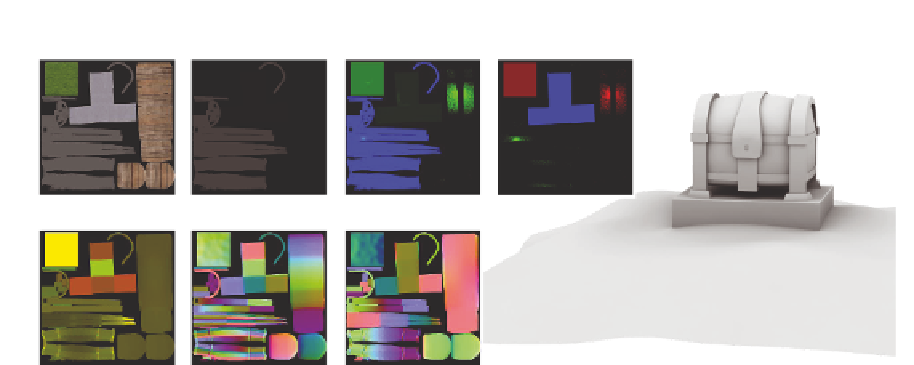Graphics Reference
In-Depth Information
Shininess
Materials (1)
Original color
Materials (2)
Texel-to-world
Normals
Tangents
Figure 3.5.
The material atlas contains all surface information. In this image a subset of the atlas textures
is shown for the Chest scene.
stored in texels of the atlas—is assignable to eight available slots. In our examples,
we needed only seven slots for water, dirt, metal, wood, organic, rust, and stone.
All in all, the material atlas contains color + shininess (RGBA8), geometric nor-
mals and tangents (2
×
RGB16F), shading normals (RGB16F), original and cur-
rent height (2
×
R16F), eight material amounts (ping-pong of 2
×
RGBA8), eight
original material amounts (2
RGBA8), and a texture-to-world scale (RG16F),
used later for equally-sized splatting. Thus, a parameterization is required for
a one-to-one relation between surface points and respective atlas coordinates,
which we obtain semi-automatically using standard DCC tools. For this, UV
maps already present in game and movie production can be reused.
The atlas resolution is the dominant factor in trading visual quality for per-
formance. To decrease the memory consumption, we reduced the amounts of
our materials to 256 discrete steps each, thus 2
×
RGBA8 textures are used for
storage.
×
3.3.2 Gammaton Transport—The Simulation Step
To attain interactive frame rates, we only compute a fixed number of simulation
steps each frame. Gammatons that are midair are marked as such and do not yet
participate in material transport. The data stored for the gammatons is shown
in Listing 3.1, including the payload carried by a gammaton during ray tracing,
which is later passed into CUDA kernels as
prd
=
p
ayload
r
ecord
d
ata, and the
persistent data stored on the OptiX side alone (position) or shared with D3D
(atlas texture coordinates of hit, material, etc.).









